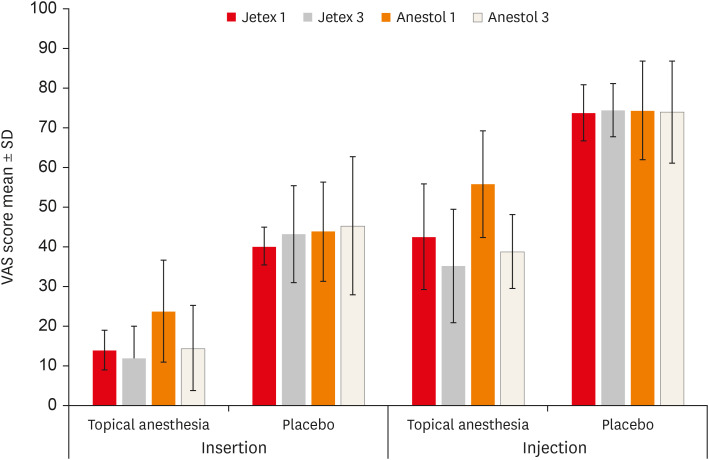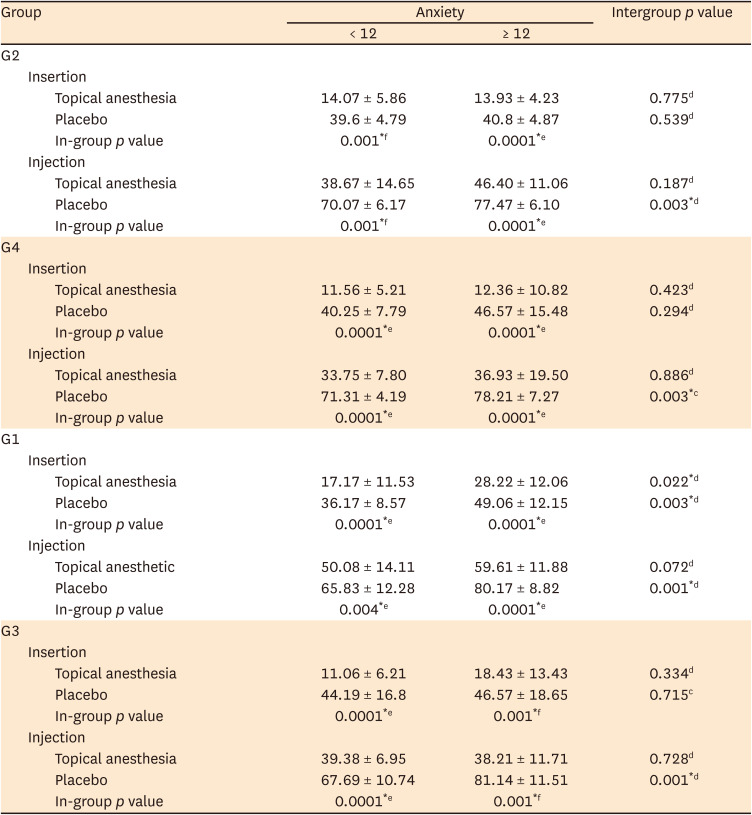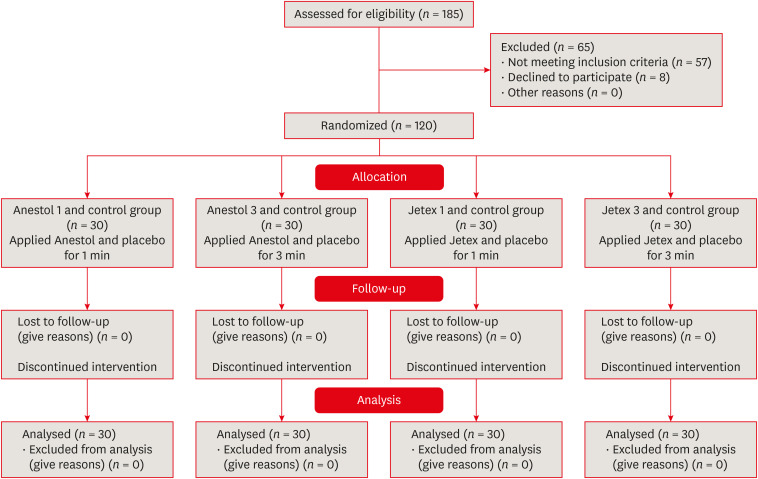1. Parirokh M, Sadeghi AS, Nakhaee N, Pardakhty A, Abbott PV, Yosefi MH. Effect of topical anesthesia on pain during infiltration injection and success of anesthesia for maxillary central incisors. J Endod. 2012; 38:1553–1556. PMID:
23146636.

2. Singh P. An emphasis on the wide usage and important role of local anesthesia in dentistry: a strategic review. Dent Res J (Isfahan). 2012; 9:127–132. PMID:
22623926.

3. Leopold A, Wilson S, Weaver JS, Moursi AM. Pharmacokinetics of lidocaine delivered from a transmucosal patch in children. Anesth Prog. 2002; 49:82–87. PMID:
15384296.
4. Nakamura S, Matsuura N, Ichinohe T. A new method of topical anesthesia by using anesthetic solution in a patch. J Endod. 2013; 39:1369–1373. PMID:
24139256.

5. Reader AW, Nusstein JM, Hargreaves KM. Local anesthesia in endodontics. Cohen’s pathways of the pulp. 10th ed. St Louis, MO: Mosby Elsevier;2011. p. 691–719.
6. van Wijk AJ, Hoogstraten J. Anxiety and pain during dental injections. J Dent. 2009; 37:700–704. PMID:
19556053.
7. van Wijk AJ, Makkes PC. Highly anxious dental patients report more pain during dental injections. Br Dent J. 2008; 205:E7. PMID:
18596822.

8. Cho SY, Kim E, Park SH, Roh BD, Lee CY, Lee SJ, Jung IY. Effect of topical anesthesia on pain from needle insertion and injection and its relationship with anxiety in patients awaiting apical surgery: a randomized double-blind clinical trial. J Endod. 2017; 43:364–369. PMID:
28110919.

9. Bågesund M, Tabrizi P. Lidocaine 20% patch vs lidocaine 5% gel for topical anaesthesia of oral mucosa. Int J Paediatr Dent. 2008; 18:452–460. PMID:
18341564.

10. Weilbach C, Hoppe C, Karst M, Winterhalter M, Raymondos K, Schultz A, Rahe-Meyer N. Effectiveness of various formulations of local anesthetics and additives for topical anesthesia - a prospective, randomized, double-blind, placebo-controlled study. J Pain Res. 2017; 10:1105–1109. PMID:
28546768.
11. Lee HS. Recent advances in topical anesthesia. J Dent Anesth Pain Med. 2016; 16:237–244. PMID:
28879311.

12. Bhalla J, Meechan JG, Lawrence HP, Grad HA, Haas DA. Effect of time on clinical efficacy of topical anesthesia. Anesth Prog. 2009; 56:36–41. PMID:
19642717.

13. Sanz R, Calpena AC, Mallandrich M, Clares B. Enhancing topical analgesic administration: review and prospect for transdermal and transbuccal drug delivery systems. Curr Pharm Des. 2015; 21:2867–2882. PMID:
25925112.

14. Vickers ER, Punnia-Moorthy A. A clinical evaluation of three topical anaesthetic agents. Aust Dent J. 1992; 37:266–270.

15. Humphris GM, Morrison T, Lindsay SJ. The Modified Dental Anxiety Scale: validation and United Kingdom norms. Community Dent Health. 1995; 12:143–150. PMID:
7584581.
16. Malamed SF. Handbook of local anesthesia-e-book. 7th ed. St Louis, MO: Elsevier Health Sciences;2019.
17. Franz-Montan M, de Paula E, Groppo FC, Silva AL, Ranali J, Volpato MC. Liposomal delivery system for topical anaesthesia of the palatal mucosa. Br J Oral Maxillofac Surg. 2012; 50:60–64. PMID:
21106282.

18. Drum M, Reader A, Beck M. Long buccal nerve block injection pain in patients with irreversible pulpitis. Oral Surg Oral Med Oral Pathol Oral Radiol Endod. 2011; 112:e51–e54. PMID:
21458333.

19. Rosa AL, Sverzut CE, Xavier SP, Lavrador MA. Clinical effectiveness of lidocaine and benzocaine for topical anesthesia. Anesth Prog. 1999; 46:97–99. PMID:
11692349.
20. Svensson P, Petersen JK. Anesthetic effect of EMLA occluded with Orahesive oral bandages on oral mucosa. A placebo-controlled study. Anesth Prog. 1992; 39:79–82. PMID:
1308377.
21. Kincheloe JE, Mealiea WL Jr, Mattison GD, Seib K. Psychophysical measurement on pain perception after administration of a topical anesthetic. Quintessence Int. 1991; 22:311–315. PMID:
1891606.
22. de Freiras GC, Pozzobon RT, Blaya DS, Moreira CH. Efficacy of benzocaine 20% topical anesthetic compared to placebo prior to administration of local anesthesia in the oral cavity: a randomized controlled trial. Anesth Prog. 2015; 62:46–50. PMID:
26061572.

23. Revill SI, Robinson JO, Rosen M, Hogg MI. The reliability of a linear analogue for evaluating pain. Anaesthesia. 1976; 31:1191–1198. PMID:
1015603.

24. McCormack HM, Horne DJ, Sheather S. Clinical applications of visual analogue scales: a critical review. Psychol Med. 1988; 18:1007–1019. PMID:
3078045.

25. Sharifi R, Salehian S, Sadeghi M, Mozaffari HR. Effect of topical anesthetics on pain during needle insertion of maxillary infiltration anesthesia: a systematic review and meta-analysis study. Sch Acad J Pharm. 2017; 6:16–26.
26. Sharifi R, Nazari H, Bolourchi P, Khazaei S, Parirokh M. The most painful site of maxillary anterior infiltrations. Dent Res J (Isfahan). 2016; 13:539–543. PMID:
28182062.

27. Yonchak T, Reader A, Beck M, Clark K, Meyers WJ. Anesthetic efficacy of infiltrations in mandibular anterior teeth. Anesth Prog. 2001; 48:55–60. PMID:
11515948.
28. Meechan JG. Intra-oral topical anaesthetics: a review. J Dent. 2000; 28:3–14. PMID:
10666956.

29. Daneshkazemi A, Abrisham SM, Daneshkazemi P, Davoudi A. The efficacy of eutectic mixture of local anesthetics as a topical anesthetic agent used for dental procedures: a brief review. Anesth Essays Res. 2016; 10:383–387. PMID:
27746520.

30. Yaacob HB, Noor GM, Malek SN. The pharmacological effect of xylocaine topical anaesthetic--a comparison with a placebo. Singapore Dent J. 1981; 6:55–57. PMID:
6953597.
31. Tunc EP, Firat D, Onur OD, Sar V. Reliability and validity of the Modified Dental Anxiety Scale (MDAS) in a Turkish population. Community Dent Oral Epidemiol. 2005; 33:357–362. PMID:
16128795.

32. Humphris GM, Hull P. Do dental anxiety questionnaires raise anxiety in dentally anxious adult patients? A two-wave panel study. Prim Dent Care. 2007; 14:7–11. PMID:
17288717.

33. Sghaireen MG, Zwiri AM, Alzoubi IA, Qodceih SM, Al-Omiri MK. Anxiety due to dental treatment and procedures among university students and its correlation with their gender and field of study. Int J Dent. 2013; 2013:647436. PMID:
23573092.

34. Dou L, Vanschaayk MM, Zhang Y, Fu X, Ji P, Yang D. The prevalence of dental anxiety and its association with pain and other variables among adult patients with irreversible pulpitis. BMC Oral Health. 2018; 18:101. PMID:
29879974.

35. Economou GC. Dental anxiety and personality: investigating the relationship between dental anxiety and self-consciousness. J Dent Educ. 2003; 67:970–980. PMID:
14518835.

36. Mehrstedt M, John MT, Tönnies S, Micheelis W. Oral health-related quality of life in patients with dental anxiety. Community Dent Oral Epidemiol. 2007; 35:357–363. PMID:
17822484.

37. Neelakantan P, Liu P, Dummer PM, McGrath C. Oral health-related quality of life (OHRQoL) before and after endodontic treatment: a systematic review. Clin Oral Investig. 2020; 24:25–36.

38. Armfield JM, Heaton LJ. Management of fear and anxiety in the dental clinic: a review. Aust Dent J. 2013; 58:390–407. PMID:
24320894.

39. Dou L, Luo J, Yang D. Anaesthetic efficacy of supplemental lingual infiltration of mandibular molars after inferior alveolar nerve block plus buccal infiltration in patients with irreversible pulpitis. Int Endod J. 2013; 46:660–665. PMID:
23331081.









 PDF
PDF Citation
Citation Print
Print




 XML Download
XML Download